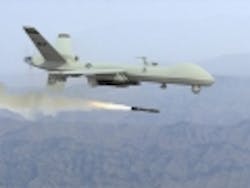DARPA seeks to improve performance of electro-optical system that helps snipers hit targets in crosswinds
ARLINGTON, Va., 23 May 2010. The U.S. Defense Advanced Research Projects Agency (DARPA) in Arlington, Va., is asking industry to make improvements to electro-optical technology developed to enable snipers to hit targets with their rifles at long ranges with only one shot in crosswind conditions.
DARPA released a broad agency announcement Friday (DARPA-BAA-10-67) for the One Shot Phase 2E program to develop a field-testable prototype observation, measurement, and ballistic calculation system that helps snipers to hit targets with the first round, under crosswind conditions, up to the maximum effective range of the weapon.
This project is a follow-on to the original One-Shot program begun in 2007, and developed under terms of a $2 million research contract by electro-optical systems experts at the Lockheed Martin Mission Systems & Sensors (MS2) segment in Akron, Ohio.
The system developed under the $7 million One Shot Phase 2E program should provide day and night direct observation of the target, measure everything that influences a bullet in flight, and rapidly calculate and display the aim point offset and expected crosswind variability in the shooters rifle scope.
The system must use technologies to operate over a range of visibilities, atmospheric turbulence, scintillation, and environmental conditions. The new effort calls for delivery of 15 operational and field-hardened systems, with purchase of as many as 100 additional units.
Previous work developed a brassboard system of a down-range unit that measured average downrange crosswind, range to target, spotter scope position, target heading, air temperature, pressure, and humidity to calculate the ballistic solution for a 0.308 bullet at ranges as far as 1,100 meters.
Although the brassboard system improved the first-round hit probability, its size, weight, and power (SWAP) were inadequate; the engagement range too short for the newest sniper weapons, and could not be used with standard rifle scopes.
The goal of phase 2E is to deliver 15 field testable and hardened prototype systems within 12 months of contract award that provides the capability to profile downrange crosswind and range to target in near real time, at longer ranges, and improved probability of a first round hit.
The integrated spotter scope (ISS) should measure crosswinds, maximum effective range of the weapon, temperature, atmospheric pressure, humidity, cant and pointing angles, and GPS coordinates, as well as allow direct day and night observation of targets with continuous updates of the aim point offset corrections, with no alignment verification of the laser/crosswind optics to the spotting scope necessary.
The rifle scope also should communicate the aim point offset and expected crosswind variability to the rifle scope using a wired or wireless data link.
Companies interested should send proposals to DARPA no later than 8 July 2010. For questions or concerns, contact the DARPA program manager, Deepak Varshneya, by e-mail at [email protected], by fax at 703-741-3880, or by post to ATTN: DARPA-BAA-10-67, 3701 North Fairfax Dr., Arlington, VA 22203-1714.
More information is online at https://www.fbo.gov/spg/ODA/DARPA/CMO/DARPA-BAA-10-67/listing.html.
